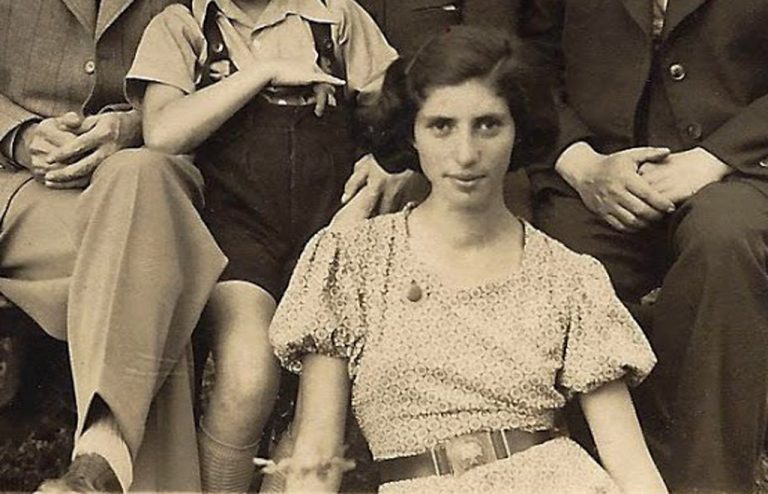PART II
On an April morning in 1944, Rose Perl awoke in her home in Visuel de Sus, Romania, to the faint sound of an insistent drumbeat. She knew where it was coming from: the town square, a few kilometers away. Like all the residents of the village, Rose knew that it meant the announcement of important news.
Rose arrived at the square with her five children in tow, finding hundreds of anxious neighbors already gathered there. Everyone noticed what was obvious, that the town’s Romanian soldiers were gone, replaced by a Hungarian force. Northern Transylvania had been annexed by Hungary.
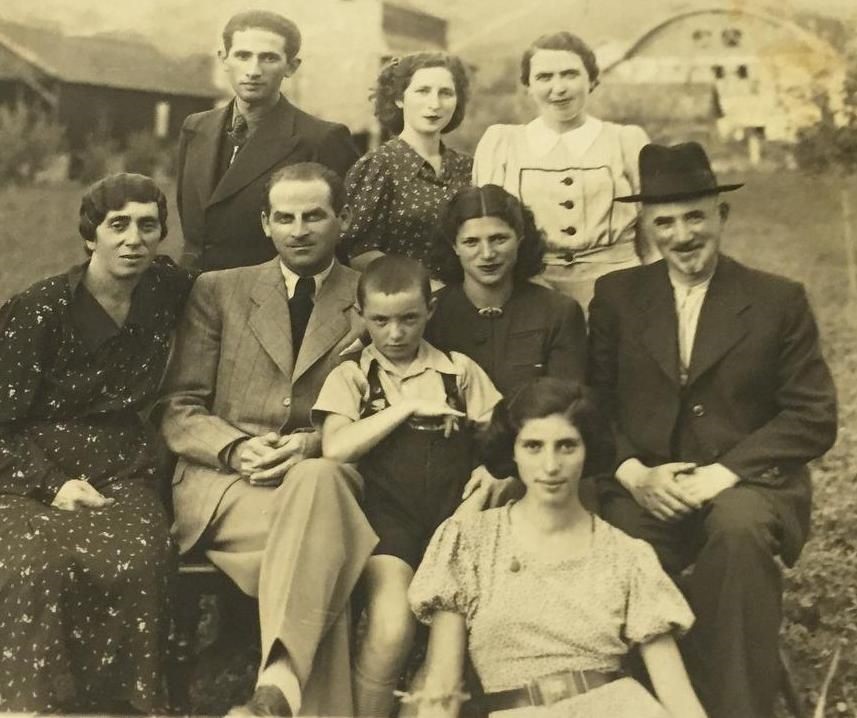
Perl family, circa 1941. Clockwise from left: Rose, Anci, Susy, Unknown, Wolf, Fritzi (sitting), Shari’s husband, Shari, Unknown Boy.
“The Hungarians wore feathers in their hats,” said my aunt, Piri, in her two-hour taped interview with Survivors of the Shoah Visual History Foundation in 1995 (where I worked as a communications manager; Steven Spielberg was chairman at the time). “We knew there was going to be trouble. The Hungarians were anti-Semitic.”
The Hungarian soldiers ordered all Jewish families to leave their homes immediately, and relocate to a designated two-block ghetto. They were told to wear a yellow Star of David armband at all times.
The Perls, for now, were spared this ordeal. They were allowed to remain at home. The Hungarian army needed the tannin produced in the family’s factory and the Perls and their foreman understood its operations.
Arrival of the Transports
Over the next weeks the Perls received favorable treatment by the Hungarians, permitted more food than the Jews in the ghetto. Aware of their plight, Rose devised secretive ways to smuggle food into the ghetto, putting herself at great risk, yet managing to succeed.
Rumors of mass deportations were thick in the air. For months, talk of the concentration camps had been spreading throughout all Europe. All Jews feared the worst.
In early May 1944, the Perls noticed several German Gestapo officers moving stealthily through Visuel, careful to keep their presence quiet. They were arranging logistics prior to the arrival of the transport trains that would carry Visuel’s Jews to the Auschwitz concentration camp 650 kilometers away in Nazi-occupied Poland.
“These officers not only hid themselves from Jewish eyes but veiled the fact of the actual trains until the last possible moment,” said Piri.
Anci, the Perl son, decided to leave. He traveled north by foot into the woods the few kilometers into Ukraine, where he was captured and forced to serve in the Russian army.
The fateful trains pulled into Visuel in mid-May. Though the Perls had escaped the ghetto, they would not elude deportation. No Jew was left in the town. Along with everyone else, the family boarded the train, never to see Romania again. The family members in their car included Rose; her four daughters, Shari, Susy, Piri, and Fritzi; Shari’s young son; and Wolf’s elderly father, Yankle Perl.
About 150 deportees were packed into each car (despite SS regulations stipulating a maximum of 50) for the journey to Auschwitz. Passengers were given no drinking water and had only a single bucket toilet. They were jammed tightly against each other with no space to move. A tiny, barred window provided inadequate ventilation. Passengers had to try to sleep standing up. Many died on the journey from suffocation and exposure.
“Our grandfather, Yankle Perl, suffered a nervous breakdown and died,” Piri said. His body, along with the others who had passed, was unceremoniously unloaded when the train stopped once each day.
Auschwitz
During their 7-month internment at Auschwitz, the sisters were not assigned to a work detail. (Auschwitz was actually three camps: a prison camp, an extermination camp, and a slave-labor camp.)
They lived in Block 16, C Lager. Twelve women crowded into the upper bunk bed and 12 below.
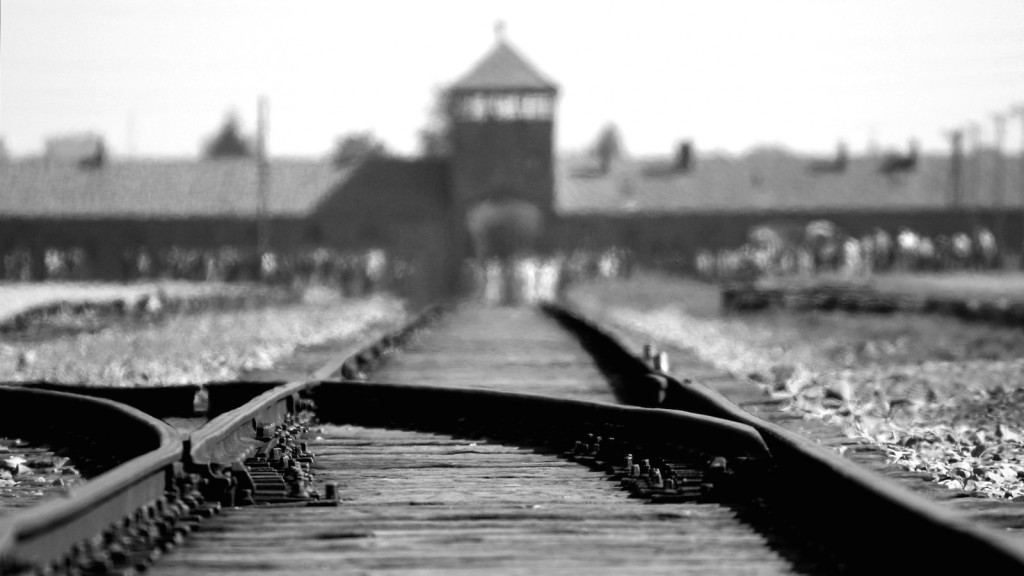
Auschwitz
At 4:30 AM each morning the female kapo (prison guard), the brutal Irma Grese, entered the building cracking a whip, yelling “Get out! Get out!” Terrified prisoners hurried to line up outside in rows of five to await inspection by the SS, stepping around the dead bodies of women who had perished during the night.
Piri recalled seeing the bodies of those who had run purposefully into the electrified fence. “Many people ran into the wire and you found them there in the morning,” she said.
Morning lineups lasted until 7 AM. Some days Josef Mengele, the Nazi doctor known as the Angel of Death, selected prisoners for execution in the gas chambers or to take part in gruesome medical experiments or pseudoscientific racial studies.
Prisoners who collapsed from exhaustion were immediately sent to the gas chambers. Once, in a lineup, Susy fainted. Piri and Fritzi hurried to grab hold of her and hold her upright, probably saving her life.
Maintaining health became difficult. “We didn’t menstruate for a year,” Fritzi said in her Shoah Foundation interview in 1995. Breakfast was unidentifiable slop, dinner a small brick of moldy bread. Sometimes they were given rotten cheese or fouled marmalade. Diarrhea was perpetual.
“You couldn’t get the runs at night because then you couldn’t go outside,” said Piri. “If you went out they shot you.” The toilet was two holes in the ground. The acrid stench of burning flesh pervaded the camp at all times.
The prisoners from Budapest, a large city, weren’t as hearty as the country-bred sisters. “The city people got sores on their feet,” said Piri. “The Gestapo took them away and they never came back.”
A Brush with Death
One typically frigid morning in October 1944, the kapo entered the barracks and announced a selection. Piri hesitated. She had a premonition. She believed the sisters would be selected to be gassed. Being the physically strongest of the three—and thus the one most likely to be spared—she stepped back in line behind Fritzi and Susy. “I figured if they’re going to put them to the left, I’m going with them,” recalled Piri.
The SS ordered the women to raise up their arms, inspecting their hands, arms and knees. The prisoners were told to wait.
“The Gestapo came with the dogs and the guns,” said Piri, “and they said they were going to give us a shower.” A “shower” often meant deadly ZyKlon B gas instead of cleansing water. Naked and terrified, the sisters entered the showers and waited.
Water flowed from the spigots. The sisters breathed.
Work Detail
A day later, they were told that all of C Block would be sent to work at a munitions factory in Germany as slave labor for the Nazi military. But this was potentially life-saving news. The sisters, along with other prisoners, were led to wait under guard at the camp’s train tracks. But a dispatcher arrived on a bicycle and handed an order to the Gestapo guard. It said that the prisoners would have to return to Auschwitz.
“Now, this was a nightmare,” said Piri. “Because if we go back, for sure they are going to burn us.”
The women were ordered into a holding room and told to remove their clothes. Said Piri, “We stayed there and we didn’t know our destiny.” Twelve hours passed.
If the Nazis were sending them to work in Germany, Piri wondered, why have them remove their clothes? “So, we were ready to die,” she said. The naked prisoners were told to bend over as attendants sprayed them with a spray that reeked like petroleum, to kill lice. Humiliated and frightened, again the sisters were sent to the showers. Again, water came.
The Salzwedel Factory
The women of C Block again were sent to the train tracks under SS guard, shivering and inadequately dressed. When the train arrived, they boarded and set off for a munitions factory in the German city of Salzwedel. It was October 1944.
The Perls and the other prisoners labored from 6 AM to 6 PM on machines making bullets. “The lead for the gunpowder was very heavy,” said Piri. “You had to pick up big things and put them on the machine.” Several of their fellow workers were war criminals. “They came from a French camp,” said Piri. “They were Catholics. There were lots of Catholics in the camps.”
The French laborers indicated that they wanted to help the Perls, but talking was prohibited. “The Gestapo walked up and down, up and down,” said Piri. “We couldn’t talk to the French. But they always told us ‘Soon, soon’.”
Ten women worked together at each station to manufacture the bullets, and if any action was incorrect or omitted, the resulting bullet was a dud. The women had an idea to subvert the Nazis, so they purposely omitted actions, creating nonfunctional bullets.
When it was time to fill a storage barrel, the women filled it three-quarters full of the duds topped off with working bullets. Inspectors usually only checked the top. However, the plan was discovered. As punishment, the Nazis selected one woman from each station and hung her. All prisoners were required to watch. If anyone looked away, the SS set their dogs on them.
Winter
Winter came, and with it, snows and sub-freezing temperatures. Each woman had only one dress and a pair of clogs. There was no soap or blankets. The sisters washed with ice they brought in from outside. At night, they warmed themselves against each other’s bodies.
Fritzi recalled always being cold, but taking it in stride. “And this was fine because there was no gas chamber and they didn’t kill people,” she said. Meals were thin soup and bread. Fritzi stole a potato once, hiding it in her pants. “She was almost hung for it,” Piri recalled.
“I don’t know how we survived,” said Piri. “We never got sick. No one got sick.”
Winter yielded to spring, 1945.
Piri did in fact get sick once. She came down with a painful toothache. She requested medical treatment, and was allowed to travel into Salzwedel with her sisters to find a dentist. But no German would treat her. The only one willing to help yanked out her tooth without the use of anesthetic.
‘Beautiful Six-Footers’
In mid-April 1945, the factory’s slave laborers paused in their work. Thunderous earth-shaking booms could be heard, shaking the building. They came closer and closer. It was a bombardment of the Allied forces’ artillery. The Americans had invaded Germany. Knowing that finally the tide had turned, the factory’s prisoners turned to face their Nazi guards, now frightened.
“The Americans came in and they shot them dead,” said Piri.
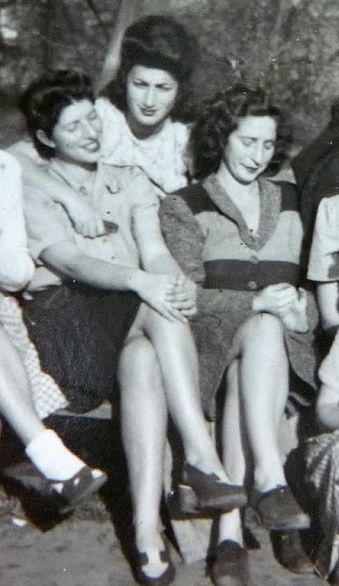
Post-war: Fritzi, Piri, Susy
Piri recalls first setting eyes on the soldiers. “Big battalions came with these men, these beautiful six-footers,” she recalled. “We wondered, why are they so big? And they told us they were the elite.” Following behind them was the U.S. army infantry. “And they weren’t so tall,” added Piri.
The sisters were told to report to a displaced persons (DP) camp, a place that still displayed the signage of a Hitler Youth Camp. “The Americans,” she said, “they gave us food and they cried. We were all sick.”
U.S. General Dwight D. Eisenhower, the Supreme Commander of the Allied Expeditionary Forces in Europe, visited the camp one day. Eisenhower had planned and managed the invasion of France and Germany. He ordered the prisoners to be evacuated because typhoid fever was breaking out.
“When the general came, the trucks came and took us away,” said Piri. “At this time we were already displaced persons.”
The Perl sisters made their way to another DP camp, this one in Paris.
Fritzi contracted typhoid fever and was sent away to be quaranteened for weeks before she was able to rejoin her sisters.
War crimes tribunals were beginning. Many of the Nazis were tried, including the sadistic kapo who had terrorized the Perls along with the other prisoners of Block C. She was found guilty and hanged.
The Perl sisters, who had befriended a group of French nationals, were presented with a celebration cake by the French on which a plastic figurine of a woman hanging in a noose was placed. Everyone cheered heartily.
Josef Mengele fled Auschwitz in January 1945, shortly before the camp was liberated by Red Army troops. He settled in South America, where he evaded capture for the rest of his life.
Estie and Luis’s Act
In Havana, in late May 1945, Luis Rosenthal (Perl sister Estie’s husband) received a letter addressed to “Family Rosenthal Havana Cuba,” which had been written by Charles Battye, a helpful British officer who was stationed at the DP camp in France where the sisters were interned. Sargent Major Battye, wanting to help the sisters, saw that his captain signed the letter. On receiving it, Estie learned for the first time that three of her siblings had survived the war. Luis immediately wired funds to pay for the sisters’ passage to Cuba by steamship.
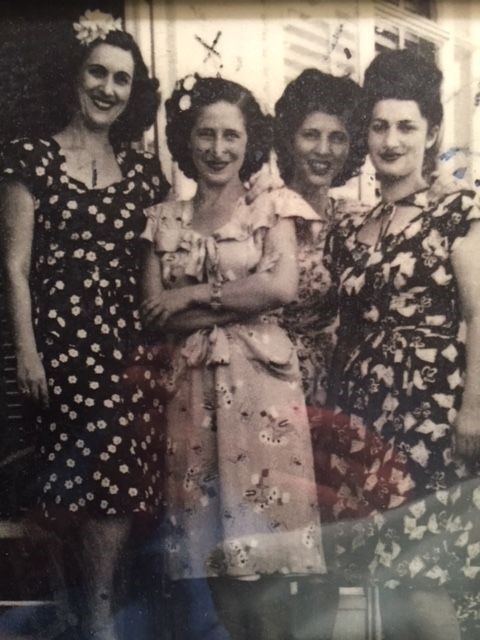
Brooklyn, 1950’s. From left: Estie, Susy, Fritzi, Piri
Piri, Susy and Fritzi sailed for Cuba, where they would live through the late 1940s.
Luis was a prosperous watchmaker and distributor, and a generous and patient man. The sisters began the healing process, ate well, socialized and played tennis, all the while trying to process what had happened to them — the loss of their family, home and country.
Around 1950, Piri met Alex Fiegler, a Hungarian who had moved to the U.S. to serve in the army (and was thereby granted automatic U.S. citizenship). Alex had received a letter and a photo from Cuba from his old friend Luis Rosenthal. Three young women were pictured in the photo: Piri, Susy and Fritzi. Alex set his sights on Piri. They married and she joined him in Brooklyn, New York.
Fritzi traveled to visit Piri and Alex in 1952, and met Harry Goldie, my father. They married, even before they spoke a common language. Harry rented a brownstone across the street from Piri’s home. In Havana, Susy married Morris Rapport.
In 1959, when Castro and the communists came to power in Cuba and began to confiscate personal property, Estie and Susy and their families emigrated to the U.S. rather than live under communist rule. They settled in Miami, having no option but to abandon their homes and possessions.
Now all the Perl families were in the U.S. Businesses were started, jobs found and children born, as the descendants of the Perl sisters thrived in New York and Miami.
♦
Anci, the Perl son, survived the war and settled in Israel in 1945. He passed away in the 1970s.
The husband of Shari, the second oldest Perl sister, managed to survive Auschwitz only to discover that his wife and child had perished there. The Perl family lost contact with him.
Though the Perl sisters have passed on, their legacy lives on in their children, grandchildren and great-grandchildren.
Piri passed away in 2011 at the age of 90. Fritzi passed away in 2016, also at 90. Estie passed away in 2018 at 104. Susy passed away in 2018 at 94.

